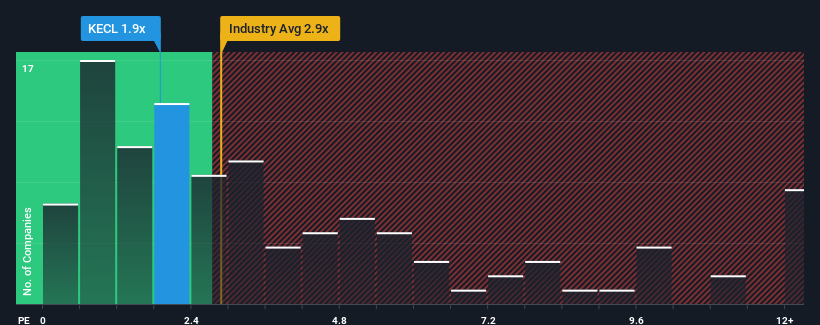- India
- /
- Electrical
- /
- NSEI:KECL
Kirloskar Electric Company Limited (NSE:KECL) Surges 35% Yet Its Low P/S Is No Reason For Excitement

Kirloskar Electric Company Limited (NSE:KECL) shareholders have had their patience rewarded with a 35% share price jump in the last month. The annual gain comes to 110% following the latest surge, making investors sit up and take notice.
In spite of the firm bounce in price, Kirloskar Electric may still be sending buy signals at present with its price-to-sales (or "P/S") ratio of 1.9x, considering almost half of all companies in the Electrical industry in India have P/S ratios greater than 2.9x and even P/S higher than 6x aren't out of the ordinary. However, the P/S might be low for a reason and it requires further investigation to determine if it's justified.
View our latest analysis for Kirloskar Electric

How Has Kirloskar Electric Performed Recently?
Recent times have been quite advantageous for Kirloskar Electric as its revenue has been rising very briskly. Perhaps the market is expecting future revenue performance to dwindle, which has kept the P/S suppressed. If that doesn't eventuate, then existing shareholders have reason to be quite optimistic about the future direction of the share price.
We don't have analyst forecasts, but you can see how recent trends are setting up the company for the future by checking out our free report on Kirloskar Electric's earnings, revenue and cash flow.Do Revenue Forecasts Match The Low P/S Ratio?
There's an inherent assumption that a company should underperform the industry for P/S ratios like Kirloskar Electric's to be considered reasonable.
Taking a look back first, we see that the company grew revenue by an impressive 31% last year. The strong recent performance means it was also able to grow revenue by 89% in total over the last three years. Accordingly, shareholders would have definitely welcomed those medium-term rates of revenue growth.
This is in contrast to the rest of the industry, which is expected to grow by 30% over the next year, materially higher than the company's recent medium-term annualised growth rates.
With this information, we can see why Kirloskar Electric is trading at a P/S lower than the industry. Apparently many shareholders weren't comfortable holding on to something they believe will continue to trail the wider industry.
What Does Kirloskar Electric's P/S Mean For Investors?
Kirloskar Electric's stock price has surged recently, but its but its P/S still remains modest. Typically, we'd caution against reading too much into price-to-sales ratios when settling on investment decisions, though it can reveal plenty about what other market participants think about the company.
In line with expectations, Kirloskar Electric maintains its low P/S on the weakness of its recent three-year growth being lower than the wider industry forecast. At this stage investors feel the potential for an improvement in revenue isn't great enough to justify a higher P/S ratio. Unless the recent medium-term conditions improve, they will continue to form a barrier for the share price around these levels.
Don't forget that there may be other risks. For instance, we've identified 3 warning signs for Kirloskar Electric (1 makes us a bit uncomfortable) you should be aware of.
If these risks are making you reconsider your opinion on Kirloskar Electric, explore our interactive list of high quality stocks to get an idea of what else is out there.
Valuation is complex, but we're here to simplify it.
Discover if Kirloskar Electric might be undervalued or overvalued with our detailed analysis, featuring fair value estimates, potential risks, dividends, insider trades, and its financial condition.
Access Free AnalysisHave feedback on this article? Concerned about the content? Get in touch with us directly. Alternatively, email editorial-team (at) simplywallst.com.
This article by Simply Wall St is general in nature. We provide commentary based on historical data and analyst forecasts only using an unbiased methodology and our articles are not intended to be financial advice. It does not constitute a recommendation to buy or sell any stock, and does not take account of your objectives, or your financial situation. We aim to bring you long-term focused analysis driven by fundamental data. Note that our analysis may not factor in the latest price-sensitive company announcements or qualitative material. Simply Wall St has no position in any stocks mentioned.
About NSEI:KECL
Kirloskar Electric
Engages in the manufacturing and sale of various electrical equipment in India and internationally.
Slight with mediocre balance sheet.
Similar Companies
Market Insights
Community Narratives




